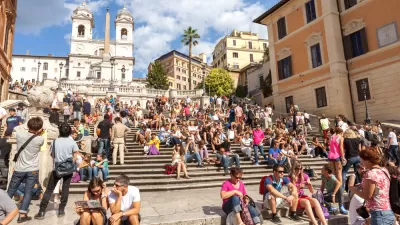With about 353 tourists per resident in the historic city center of Venice, many residents are fleeing the crowds and moving onto the mainland, making the city a "monument-attraction," rather than a viable living space.
As Marilena Mela writes for Global Site Plans, Italy is known for its stunning landscapes, rich culture, and mild climate, drawing about 46 million visitors every year. In many of the art cities featuring prominent works by influential artists, the influx of tourists in recent years is leading to a reevaluation of the tourism industry's benefits.
These visitors, many who are day-trippers or cruise-goers, "take a quick look at the canals and narrow roads, and return to their ship without contributing to the city’s economy. The touristic invasion, in combination with the flooding problem that continues to worsen, has led to an abandonment of the city center." Indeed, compared to other Italian cities, Venice and Rome host the greatest number of tourists, and a recent study by Sapienza Univeristy of Rome found “that the authentic character of the city is in danger of alteration, due to low quality facilities that represent a 'fast' tourism." In addition, "the overcrowding of the city center of Florence by tourists also seems to be a constant cause of stress for its inhabitants, as indicated by a 2012 study published in the journal Tourism Geographies."
With these impacts from tourism in mind, how can urban planners and architects use policies to minimize the detrimental affects and protect, but still showcase, historic cities?
Thanks to Renée van Staveren for the heads up.

Planetizen Federal Action Tracker
A weekly monitor of how Trump’s orders and actions are impacting planners and planning in America.

Maui's Vacation Rental Debate Turns Ugly
Verbal attacks, misinformation campaigns and fistfights plague a high-stakes debate to convert thousands of vacation rentals into long-term housing.

Restaurant Patios Were a Pandemic Win — Why Were They so Hard to Keep?
Social distancing requirements and changes in travel patterns prompted cities to pilot new uses for street and sidewalk space. Then it got complicated.

In California Battle of Housing vs. Environment, Housing Just Won
A new state law significantly limits the power of CEQA, an environmental review law that served as a powerful tool for blocking new development.

Boulder Eliminates Parking Minimums Citywide
Officials estimate the cost of building a single underground parking space at up to $100,000.

Orange County, Florida Adopts Largest US “Sprawl Repair” Code
The ‘Orange Code’ seeks to rectify decades of sprawl-inducing, car-oriented development.
Urban Design for Planners 1: Software Tools
This six-course series explores essential urban design concepts using open source software and equips planners with the tools they need to participate fully in the urban design process.
Planning for Universal Design
Learn the tools for implementing Universal Design in planning regulations.
Heyer Gruel & Associates PA
JM Goldson LLC
Custer County Colorado
City of Camden Redevelopment Agency
City of Astoria
Transportation Research & Education Center (TREC) at Portland State University
Jefferson Parish Government
Camden Redevelopment Agency
City of Claremont



























